Understanding NCS5500 Jericho+ Systems and their scalability
You can find more content related to NCS5500 including routing memory management, VRF, URPF, ACLs, Netflow following this link.
S01E06 Introduction of the Jericho+ based platforms and impact on the scale
Update: This article has been edited in June 2018 to fix an error on the 6.3.2 behavior.
Update2: In August 2018, we added information on the MOD systems and line cards.
Update3: In Nov 2019, clarification on the lack of MACsec support on 1G interfaces.
Update4 in IOS XR 7.3.1, we will decommission the “internet-optimized” mode, please check this article: https://xrdocs.io/ncs5500/tutorials/decommissioning-internet-optimized-mode/
Previously on “Understanding NCS5500 Resources”
In previous posts, we presented:
- the different routers and line cards in NCS5500 portfolio
- we explained how IPv4 prefixes are sorted in LEM, LPM and eTCAM
- we covered how IPv6 prefixes are stored in the same databases.
- we demonstrated in a video how we can handle a full IPv4 and IPv6 Internet view on “Base” systems and line cards (i.e. without external TCAM, only using the LEM and LPM internal to the forwarding ASIC)
- finally in the fifth post, we demonstrated in another video the scale we can reach on Jericho-based systems with an external TCAM
In this episode we will introduce and study a second generation of line cards and systems based on an evolution of the Forwarding ASIC.
Jericho+
This Forwarding ASIC from Broadcom re-uses all of the principles of the Jericho generation, simply extending some scales:
- the bandwidth capabilities and consequently, the interfaces count: we can now accomodate 9x 100G interfaces line rate per ASIC
- the forwarding capability , extending it to 835MPPS (the performance is the same with lookups in internal databases or external TCAM)
- some memories like LPM (for certain models) and EEDB. Also we will use a new generation eTCAM (significantly larger).
“Certain models”? Yes, J+ exists in different flavors. Some are re-using the same LEM/LPM scale than Jericho and some others have a larger LPM memory (qualified for 1M to 1.3M instead of 256K to 350+K IPv4 entries).
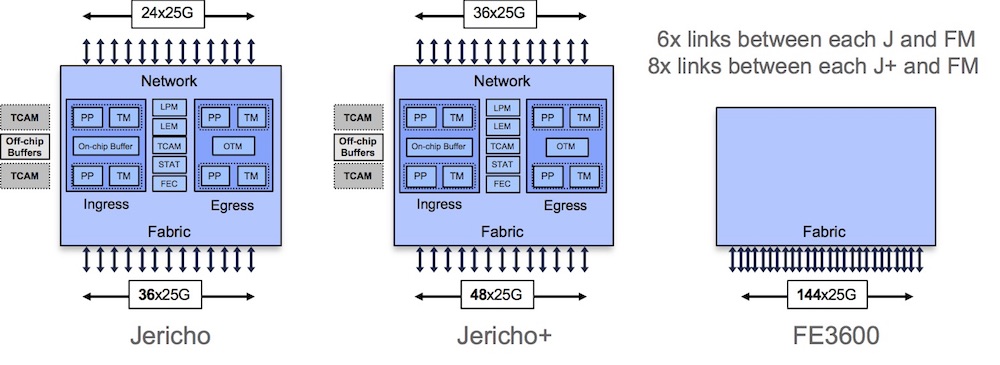
Both Jericho and Jericho+ can be used with current Fabric Cards (FE3600). Some restrictions may apply for the 16-slot chassis, please contact your local account team to discuss the specifics.
New systems using this J+ ASIC
In the modular chassis:
In March 2018, we had a single line card using Jericho+: the 36x100G-A-SE (more LC are coming in the summer).

The line card is timing capable (note: an RP-E is necessary to use these timing features) and only exists in scale version (with eTCAM). The supported scale in current release is 4M+ IPv4 entries. It does not include MACsec chipset. It’s also the first line card supporting break-out cable 4x 25G.
Internally, the line is composed of 4 Jericho+ (each one handling 9 ports QSFP). As shown in this diagram, each Jericho+ Forwarding ASIC is connected to the fabric cards via 8x 25G SERDES instead of 6 in the case of Jericho-based line cards.
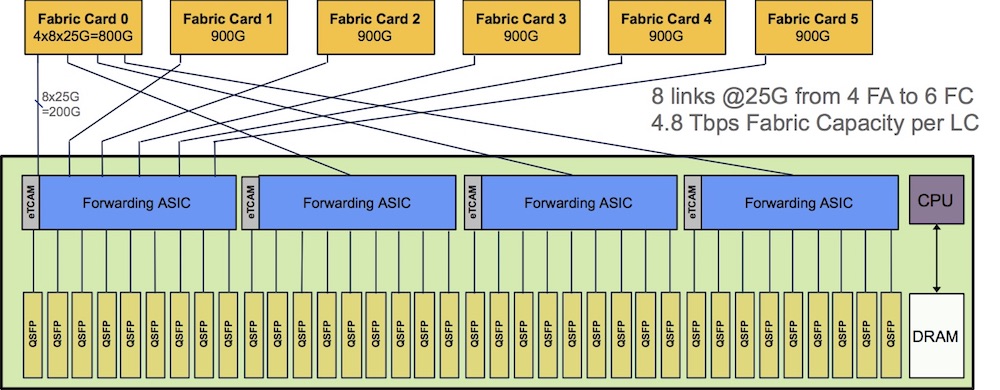
In July 2018, we added the support of MOD line cards: NC55-MOD-A-S

This line card offers more flexbility with fixed ports and two MPA bays. It’s powered by a single Jericho+ ASIC.
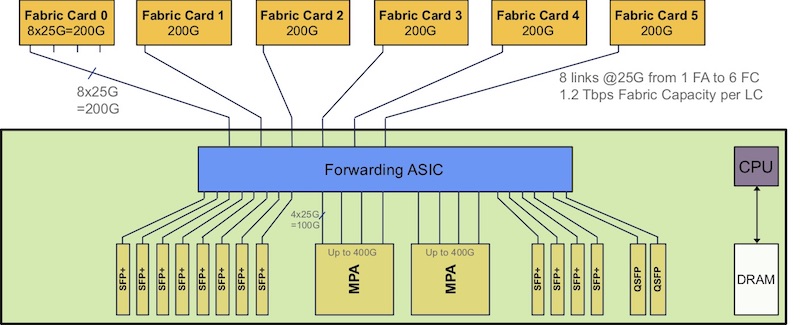
We are also extending the fixed-form factor portfolio with 3x 1RU and 2x 2RU
- NCS55A1-36H-S
- NCS55A1-36H-SE-S
- NCS55A1-24H
- NCS-55A2-MOD-HD-S
- NCS-55A2-MOD-S
Let’s get started with the 36 ports options.
These standalone systems are MACsec + timing capable and are available in base (NCS55A1-36H-S) and scale versions (NCS55A1-36H-SE-S). Both have the same port density.
The base version shows the same route scale than a Jericho systems without external TCAM while the scale version uses a new generation eTCAM extending the scale to 4M IPv4 routes (potentially much more in the future).

Internally, the system is composed of 4 Jericho+ ASICs (each one handling 9 ports QSFP) interconnected via an FE3600 chipset.
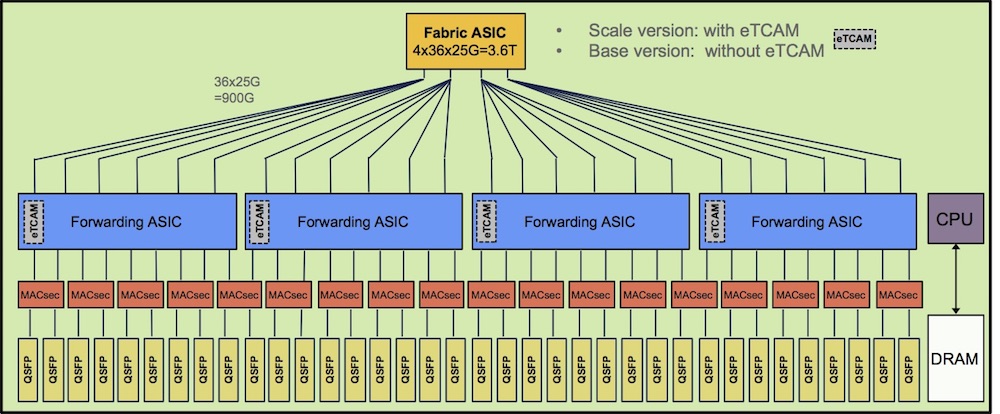
The third router: NCS55A1-24H.
It’s a cost optimized, oversubscribbed, system that provides 24 ports QSFP. It is timing-capable but doesn’t support MACsec.

As shown in this diagram, the forwarding ASICs are connected back-to-back without using any fabric engine. Each ASIC handles 12 ports for a 900Gbps forwarding capability (hence the oversubscription).
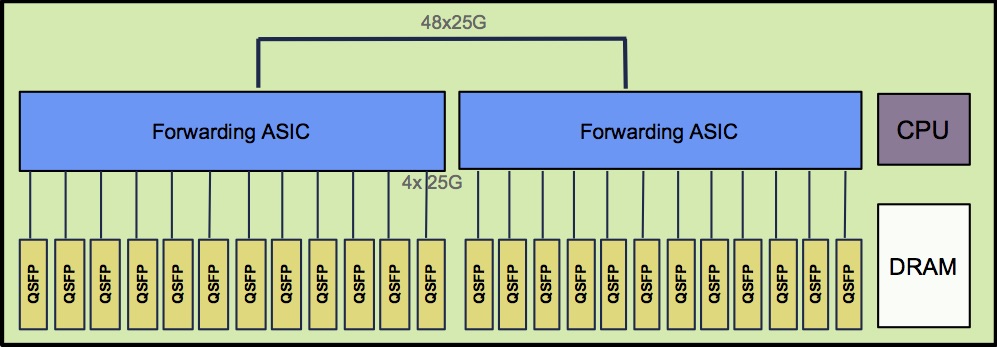
We will describe it in more details in the next sections but this system uses the largest version of Jericho+ ASICs. It doesn’t use external TCAM but has a large LPM (1M to 1.3M prefixes instead of the 256K-350K we use on other systems in chassis or in the NCS55A1-36H-S).
Moving on the second category, the 2-RU Modular Fixed Systems:
Modular and Fixed… Hmmm…
Indeed these routers are not chassis in the sense they don’t have slots to host line cards, but still they offer a lot of flexbility. They offer both fixed ports (40x SFP+) and two bays to host MPAs:
- 12x 10G, with 10G LAN, WAN, OTN, 10G DWDM
- 2x CFP2_DCO (OTN, 100G/200G DWDM)
- 1x CFP2_DCO (OTN, 100G/200G DWDM) + 2x QSFP28 (4x10G / 40G / 100G)
- 4x QSFP28 (4x10G / 40G /100G)
In 6.5.1, we offer two flavors of the chassis: base and hardened. The second being temperature hardened, it can support more challenging environmental conditions.

The system is powered by a single Jericho+ and is capable of MACsec on the 16 first ports and on MPAs. Note that MACsec is not supported with 1G optics.
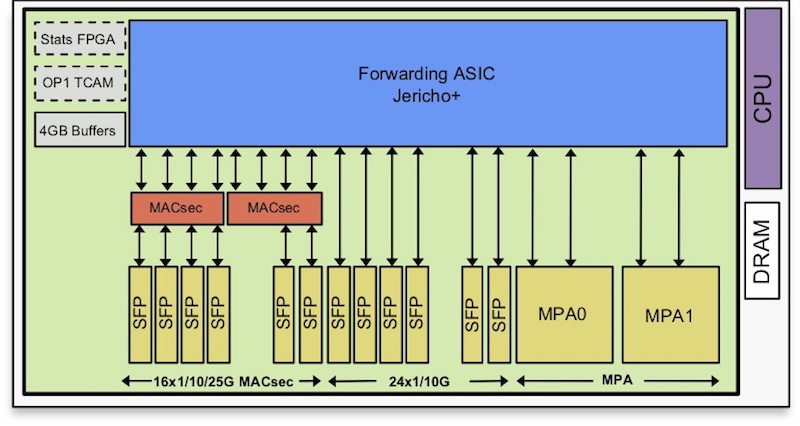
Let’s talk about route scale
First, a quick reminder: the order of operation for route lookup in the NCS5500 family. It applies for both Jericho and Jericho+ systems.
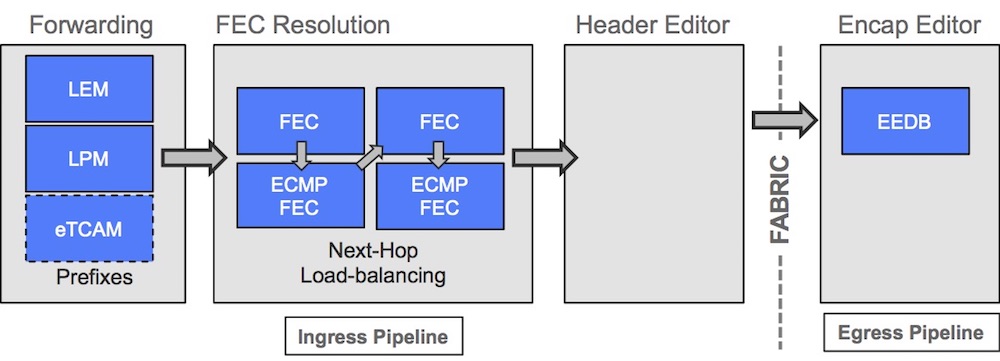
The prefixes are stored in LEM, LPM and when possible eTCAM.
NCS55A1-36H-S / NCS-55A2-MOD-HD-S / NCS-55A2-MOD-S Scale
On these systems, the principles of prefixes storage are exactly the same than Jericho systems without eTCAM.
So it’s possible to use two different modes:
- by default: the host mode

- changed by configuration: the internet mode
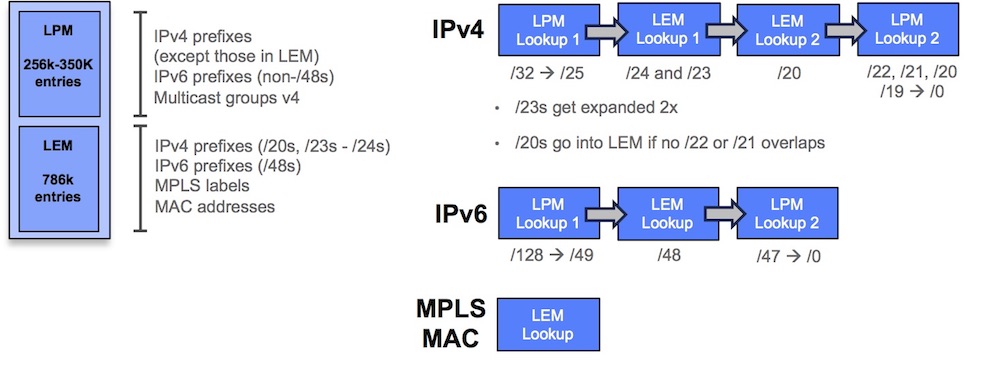
I invite you take a look at the second and third episode of this series. You will find detailed explanations and examples with real internet views.
NCS55A1-36H-SE-S Scale
The NCS55A1-36H-SE-S is using the same Jericho+ ASIC but completed with a new generation and much larger external TCAM. In current release, it’s certified for 4M IPv4 prefixes but the memory capabilities are significantly larger. We will decide in the future if it’s necessary to increase the tested/validated scale.
Also, please note that the way we sort routes is different between 6.3.15 and 6.3.2.
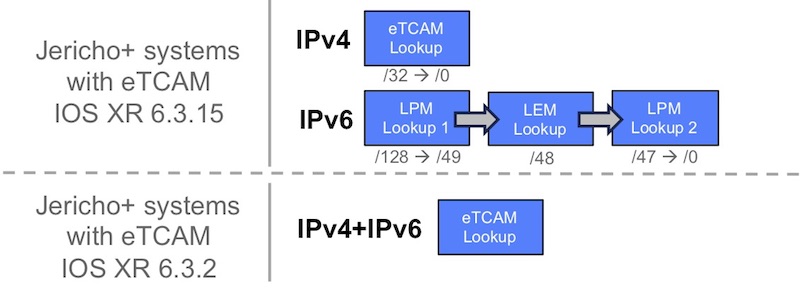
The uRPF does not affect the scale of this eTCAM (on the contrary of the first generation where it was necessary to disable the dual capacity feature, reducing the eTCAM to 1M entries). Also, the hybrid ACLs are using a different zone of the eTCAM memory and don’t affect the overall scale.
RP/0/RP0/CPU0:5508-6.3.2#sh route sum
Route Source Routes Backup Deleted Memory(bytes)
local 7 0 0 1680
local LSPV 1 1 0 480
connected 6 1 0 1680
static 1 0 0 240
ospf 1 5 0 0 1200
bgp 100 1186410 0 0 284738400
isis 1 0 0 0 0
dagr 0 0 0 0
Total 1186430 2 0 284743680
RP/0/RP0/CPU0:5508-6.3.2#sh route ipv6 sum
Route Source Routes Backup Deleted Memory(bytes)
local 7 0 0 1848
local LSPV 1 1 0 528
connected 5 2 0 1848
connected l2tpv3_xconnect 0 0 0 0
static 0 0 0 0
bgp 100 58860 0 0 15539040
isis 1 0 0 0 0
Total 58873 3 0 15543264
RP/0/RP0/CPU0:5508-6.3.2#sh dpa resource iproute loc 0/1/CPU0
"iproute" DPA Table (Id: 24, Scope: Global)
--------------------------------------------------
IPv4 Prefix len distribution
Prefix Actual Prefix Actual
/0 5 /1 0
/2 0 /3 0
/4 5 /5 0
/6 0 /7 0
/8 16 /9 13
/10 35 /11 106
/12 285 /13 550
/14 1066 /15 1880
/16 13419 /17 7773
/18 13636 /19 25026
/20 38261 /21 43073
/22 80751 /23 67073
/24 376991 /25 567
/26 2032 /27 4863
/28 15599 /29 16868
/30 41735 /31 52
/32 434792
NPU ID: NPU-0 NPU-1 NPU-2 NPU-3
In Use: 1186472 1186472 1186472 1186472
Create Requests
Total: 1186472 1186472 1186472 1186472
Success: 1186472 1186472 1186472 1186472
Delete Requests
Total: 0 0 0 0
Success: 0 0 0 0
Update Requests
Total: 8 8 8 8
Success: 6 6 6 6
EOD Requests
Total: 0 0 0 0
Success: 0 0 0 0
Errors
HW Failures: 0 0 0 0
Resolve Failures: 0 0 0 0
No memory in DB: 0 0 0 0
Not found in DB: 0 0 0 0
Exists in DB: 0 0 0 0
RP/0/RP0/CPU0:5508-6.3.2#sh dpa resource ip6route loc 0/1/CPU0
"ip6route" DPA Table (Id: 25, Scope: Global)
--------------------------------------------------
IPv6 Prefix len distribution
Prefix Actual Capacity Prefix Actual Capacity
/0 5 0 /1 0 0
/2 0 0 /3 0 0
/4 0 0 /5 0 0
/6 0 0 /7 0 0
/8 0 0 /9 0 0
/10 5 0 /11 0 0
/12 0 0 /13 0 0
/14 0 0 /15 0 0
/16 16 0 /17 0 0
/18 0 0 /19 2 0
/20 9 0 /21 3 0
/22 4 0 /23 4 0
/24 19 0 /25 6 0
/26 15 0 /27 17 0
/28 78 0 /29 1848 0
/30 153 0 /31 127 0
/32 9279 0 /33 487 0
/34 345 0 /35 357 0
/36 1436 0 /37 199 0
/38 673 0 /39 154 0
/40 2239 0 /41 206 0
/42 369 0 /43 113 0
/44 2213 0 /45 178 0
/46 1451 0 /47 356 0
/48 19222 0 /49 0 0
/50 0 0 /51 1 0
/52 1 0 /53 0 0
/54 0 0 /55 0 0
/56 11540 0 /57 16 0
/58 0 0 /59 0 0
/60 0 0 /61 0 0
/62 0 0 /63 0 0
/64 4940 0 /65 0 0
/66 0 0 /67 0 0
/68 0 0 /69 0 0
/70 0 0 /71 0 0
/72 0 0 /73 0 0
/74 0 0 /75 0 0
/76 0 0 /77 0 0
/78 0 0 /79 0 0
/80 0 0 /81 0 0
/82 0 0 /83 0 0
/84 0 0 /85 0 0
/86 0 0 /87 0 0
/88 0 0 /89 0 0
/90 0 0 /91 0 0
/92 0 0 /93 0 0
/94 0 0 /95 0 0
/96 1 0 /97 0 0
/98 0 0 /99 0 0
/100 0 0 /101 0 0
/102 0 0 /103 0 0
/104 6 0 /105 0 0
/106 0 0 /107 0 0
/108 0 0 /109 0 0
/110 0 0 /111 0 0
/112 0 0 /113 0 0
/114 0 0 /115 4 0
/116 0 0 /117 0 0
/118 0 0 /119 0 0
/120 0 0 /121 0 0
/122 71 0 /123 0 0
/124 0 0 /125 0 0
/126 0 0 /127 18 0
/128 722 0
NPU ID: NPU-0 NPU-1 NPU-2 NPU-3
In Use: 58908 58908 58908 58908
Create Requests
Total: 58908 58908 58908 58908
Success: 58908 58908 58908 58908
Delete Requests
Total: 0 0 0 0
Success: 0 0 0 0
Update Requests
Total: 2 2 2 2
Success: 1 1 1 1
EOD Requests
Total: 0 0 0 0
Success: 0 0 0 0
Errors
HW Failures: 0 0 0 0
Resolve Failures: 0 0 0 0
No memory in DB: 0 0 0 0
Not found in DB: 0 0 0 0
Exists in DB: 0 0 0 0
RP/0/RP0/CPU0:5508-6.3.2#sh contr npu resources lem loc 0/1/CPU0
HW Resource Information
Name : lem
OOR Information
NPU-0
Estimated Max Entries : 786432
Red Threshold : 95
Yellow Threshold : 80
OOR State : Green
-- SNIP --
Current Usage
NPU-0
Total In-Use : 0 (0 %)
iproute : 0 (0 %)
ip6route : 0 (0 %)
mplslabel : 4 (0 %)
-- SNIP --
RP/0/RP0/CPU0:5508-6.3.2#sh contr npu resources lpm loc 0/1/CPU0
HW Resource Information
Name : lpm
OOR Information
NPU-0
Estimated Max Entries : 338879
Red Threshold : 95
Yellow Threshold : 80
OOR State : Green
-- SNIP --
Current Usage
NPU-0
Total In-Use : 26 (0 %)
iproute : 0 (0 %)
ip6route : 0 (0 %)
ipmcroute : 1 (0 %)
-- SNIP --
RP/0/RP0/CPU0:5508-6.3.2#sh contr npu resources exttcamipv4 loc 0/1/CPU0
HW Resource Information
Name : ext_tcam_ipv4
OOR Information
NPU-0
Estimated Max Entries : 4000000
Red Threshold : 95
Yellow Threshold : 80
OOR State : Green
-- SNIP --
Current Usage
NPU-0
Total In-Use : 1186457 (30 %)
iproute : 1186472 (30 %)
-- SNIP --
RP/0/RP0/CPU0:5508-6.3.2#sh contr npu resources exttcamipv6 loc 0/1/CPU0
HW Resource Information
Name : ext_tcam_ipv6
OOR Information
NPU-0
Estimated Max Entries : 2000000<
Red Threshold : 95
Yellow Threshold : 80
OOR State : Green
-- SNIP --
Current Usage
NPU-0
Total In-Use : 58878 (3 %)
ip6route : 58908 (3 %)
-- SNIP --
RP/0/RP0/CPU0:5508-6.3.2#sh contr npu externaltcam loc 0/1/CPU0
External TCAM Resource Information
=============================================================
NPU Bank Entry Owner Free Per-DB DB DB
Id Size Entries Entry ID Name
=============================================================
0 0 80b FLP 7300158 1186457 0 IPv4 UC
0 1 80b FLP 0 0 1 IPv4 RPF
0 2 160b FLP 10963645 58878 3 IPv6 UC
0 3 160b FLP 0 0 4 IPv6 RPF
0 4 80b FLP 4096 0 81 INGRESS_IPV4_SRC_IP_EXT
0 5 80b FLP 4096 0 82 INGRESS_IPV4_DST_IP_EXT
0 6 160b FLP 4096 0 83 INGRESS_IPV6_SRC_IP_EXT
0 7 160b FLP 4096 0 84 INGRESS_IPV6_DST_IP_EXT
0 8 80b FLP 4096 0 85 INGRESS_IP_SRC_PORT_EXT
0 9 80b FLP 4096 0 86 INGRESS_IPV6_SRC_PORT_EXT
-- SNIP --
RP/0/RP0/CPU0:5508-6.3.2#
NCS55A1-24H Scale
The NCS55A1-24H is very different from the other NCS5500 routers because it uses a pair of Jericho+ with large LPM. So it occupies a particular place between the non-eTCAM and the eTCAM systems.
This large LPM is algorithmic, so even if it’s marketed for 1M IPv4 entries, it can fit much more depending on the prefix distribution:
HW Resource Information
Name : lem
OOR Information
NPU-0
Estimated Max Entries : 786432
Red Threshold : 95
Yellow Threshold : 80
OOR State : Green
HW Resource Information
Name : lpm
OOR Information
NPU-0
Estimated Max Entries : 1384333
Red Threshold : 95
Yellow Threshold : 80
OOR State : Green
Like the other non-eTCAM systems, we can use two different configurations: the host-optimized mode (default) and the internet-optimized mode.
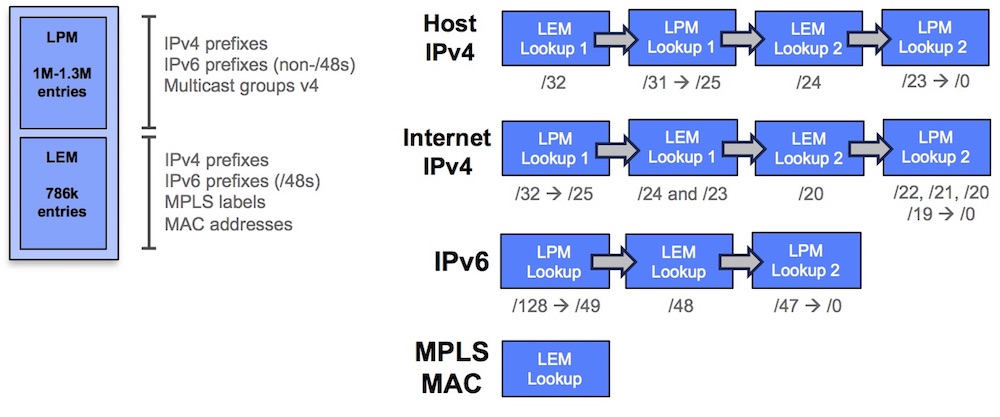
Note: in IOS XR 7.3.1, we will decommission the “internet-optimized” mode, please check this article: https://xrdocs.io/ncs5500/tutorials/decommissioning-internet-optimized-mode/
Let’s take a full internet table made of 655487 v4 and 42852 v6 real routes and check how it fits in this system.
With the host optimized mode:
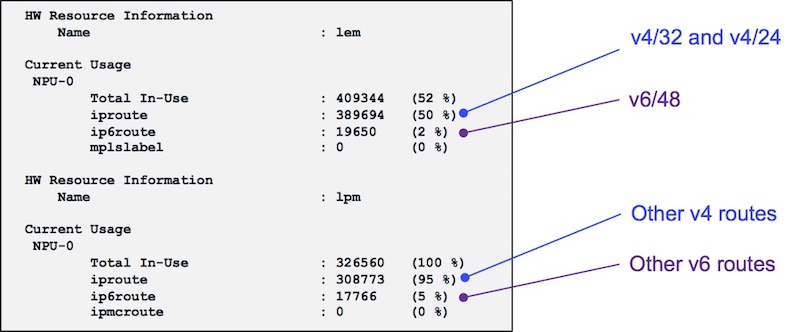
And with the internet optimized mode:
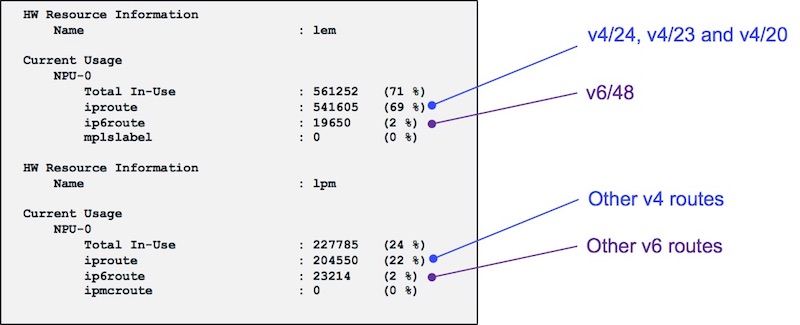
Conclusion
Three different options with the Jericho+ systems: J+ with Jericho-scale, J+ with large LPM, J+ with new generation eTCAM. They are used in one new line card offering very high route scalability (4M+ routes), and in three new 1RU systems.
Leave a Comment